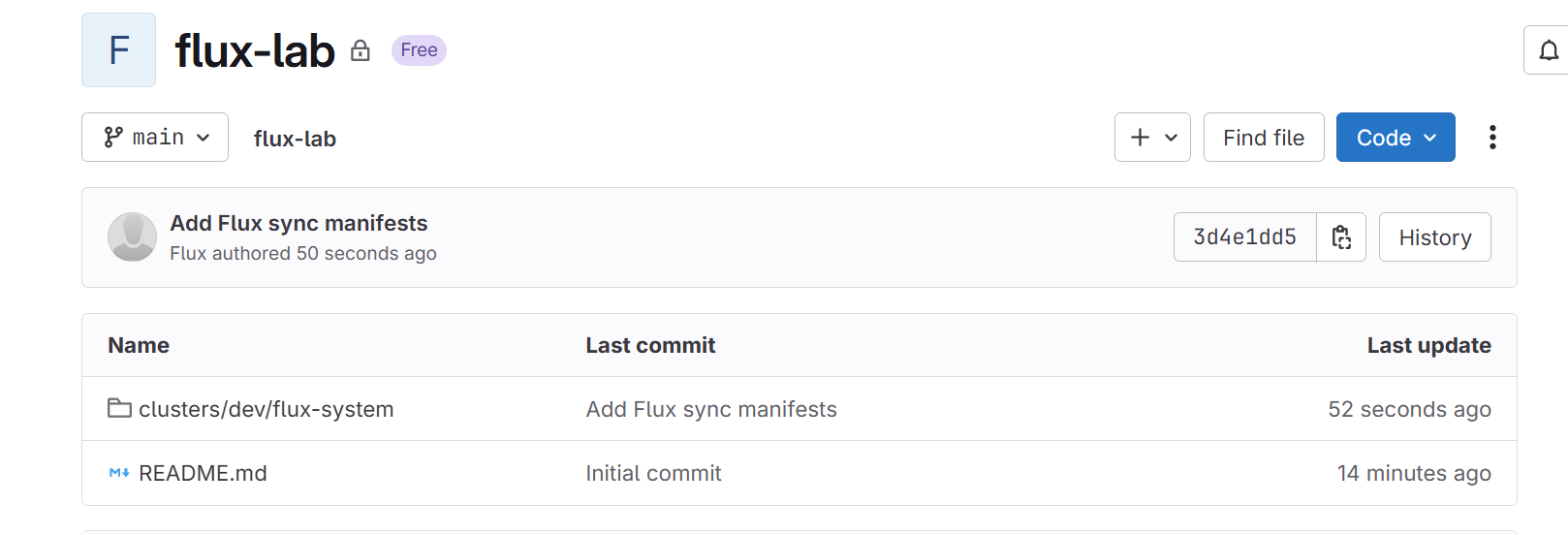Setting Up Flux
Overview
This guide shows how to install Flux CD and link it to a Git repository. This helps automate Kubernetes setups using Git as the source of truth.
- Works on Windows, macOS, Linux
- Needs Kubernetes v1.23 or newer
Flux CD is installed as a command-line tool. It works by pulling setup files from a Git repository.
Pre-requisites
Download Flux CLI Tool
Install the Flux command-line tool:
-
For Mac users - Using homebrew
brew install fluxcd/tap/flux -
Windows users - Using the official script:
curl -s https://fluxcd.io/install.sh | sudo bash
To verify:
flux --version
Now that Flux is installed, you can use it to bootstrap your Kubernetes cluster with your Git repo.
Prepare the Git Repository
Make sure you have a Github or Gilab account for this step.
Create a Git repository to store Flux CD settings.
-
Make a new Git repository (e.g.
flux-lab) -
Clone it to your computer:
git clone https://git.example.com/yourname/flux-lab.git
cd flux-lab -
Create folder structure:
mkdir -p clusters/dev/flux-system
Here, "dev" is a name for the config, not the cluster itself. Same config can be reused across clusters.
Create Flux Config Files
Create the required empty files - Flux will fill them later.
cd clusters/dev/flux-system
touch gotk-components.yaml gotk-sync.yaml kustomization.yaml
Edit the kustomization.yaml. This tells Flux where to find the config files.
apiVersion: kustomize.config.k8s.io/v1beta1
kind: Kustomization
resources:
- gotk-components.yaml
- gotk-sync.yaml
Save the files to Git.
git add .
git commit -m "initial commit"
git push
Only the customization file has content. Flux will update the rest.
Create Git Access Token
Flux needs permission to update the repository.
- Go to your Git service (e.g. GitLab)
- Create a personal access token.
- Make sure to enable "API" permission
- Save the token somewhere safe
This token acts like a password. You won’t see it again so make sure to write it down and store in a safe location.
Next, export the token as an environment variable in your terminal:
export GITLAB_TOKEN=your_token_here
Bootstrap Flux CD to Cluster
We now install Flux to the Kubernetes cluster using the Git repo.
flux bootstrap gitlab \
--owner=yourname \
--repository=flux-lab \
--branch=main \
--path=clusters/dev \
--token-auth \
--personal
Flux connects to Git, fills in the config files, pushes changes, and installs itself to the cluster. You can verify this by going to your Git service and checking that Flux commited the new folder and files.

Confirm Flux is Installed
Check the running pods in the cluster:
kubectl get pods -n flux-system
You should see:
NAME READY STATUS RESTARTS AGE
helm-controller-56dd4978f9-55mr8 1/1 Running 0 9m41s
kustomize-controller-7d7f548549-vrbd7 1/1 Running 0 9m41s
notification-controller-7fcdddb774-5tvnx 1/1 Running 0 9m41s
source-controller-5f9497cc5d-9kq66 1/1 Running 0 9m41s
These controllers handle syncing and updates from Git.
Difference with ArgoCD
Unlike some tools like Argo CD, Flux doesn’t run as a single named pod. It uses multiple lightweight controllers. You don’t need a parent cluster. Just run the same bootstrap command to set up another cluster.
How Flux Connects to the Repository
FluxCD works by watching a Git repository for changes and syncing them to your Kubernetes cluster.
- It uses a custom resource called
gitrepo - It watches a specific branch (like
mainordev) - It checks for changes regularly and applies them
So when you install FluxCD, it knows where to look based on your setup. The Git repo CRD tells FluxCD what to watch and where. You can see this by running:
$ kubectl get gitrepo -n flux-system
NAME URL AGE READY STATUS
flux-system https://gitlab.com/user/flux-lab.git 15m True stored artifact for revision 'main@sha1:123456789123456789123456789'
Secrets Used by FluxCD
To connect to a private Git repo, FluxCD uses a secret token that was created in the Git service.
- The token is stored in a Kubernetes secret
- The token gives FluxCD access to the Git repo
You can see the secret by running:
$ kubectl get secret -n flux-system
NAME TYPE DATA AGE
flux-system Opaque 2 20m
You can also decode the secret using:
kubectl get secret flux-system -n flux-system -o jsonpath="{.data.password}" | base64 -d
This is the same token you used when bootstrapping FluxCD. Only admins should have access to this secret.
Cluster Roles
FluxCD applies files from Git to your cluster using permissions.
- It uses a cluster role binding called
cluster-reconciler - This role lets it apply resources using cluster-admin access
You can view these permissions with:
$ kubectl get clusterrolebindings | grep flux
cluster-reconciler-flux-system ClusterRole/cluster-admin 22m
crd-controller-flux-system ClusterRole/crd-controller-flux-system 22m
FluxCD checks and syncs resources regularly to keep them aligned with your Git state.